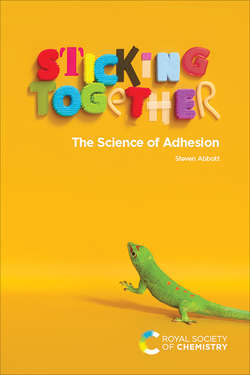Читать книгу Sticking Together - Steven Abbott - Страница 21
На сайте Литреса книга снята с продажи.
2.10 POLYMERS
ОглавлениеMany adhesives are polymers and a lot of adhesion is to polymers. To avoid tedium, I will sometimes use abbreviations for many of the common polymers.
| • EVA | (Poly)Ethylene vinyl acetate |
| • EVOH | (Poly)Ethylene vinyl alcohol |
| • PE | Polyethylene, commonly called polythene |
| • HDPE/LDPE | High Density PE and Low Density PE |
| • PP | Polypropylene |
| • PMMA | Polymethylmethacrylate, commonly called Perspex or Plexiglas |
| • PC | Polycarbonate |
| • PET | Polyethyleneterephthalate, commonly called polyester |
| • PDMS | Polydimethylsiloxane, commonly called silicone |
| • PTFE | Polytetrafluoroethylene, commonly called Teflon |
| • PVOH | Polyvinylalcohol |
| • PVA | Polyvinylacetate; confusingly PVA can also mean polyvinylalcohol |
| • PVB | Polyvinylbutyral |
| • PVP | Polyvinylpyrrolidone |
We cannot understand adhesion and, especially, the trade-offs between strength, hardness and toughness without understanding a few polymer basics.
The simplest polymers are “vinyl” molecules, i.e. they are formed from those carbon–carbon double bonds mentioned earlier (the double bond is denoted in text by an sign, so: CC), to create a string of carbon–carbon single bonds (denoted by a dash ‘–’, so: C–C). As mentioned above, by convention the drawings do not include the hydrogen atoms that are also attached to the carbon atoms. In another convention, other groups attached to the carbon–carbon double bond can be denoted by the letter ‘R’.
Let's first make some polyethylene. We start with ethylene, CCR, where R happens to be hydrogen. We react it with a molecule called a “radical”. We will show (Figure 2.11) it as X˙ where the dot indicates that the molecule is keen to react. Where the first X˙ (an “initiator”) comes from will be discussed later. If we add X˙ to CC we get X–C–C˙. The dot on the X has reacted with one of the carbons, leaving a new free dot (radical) on the other carbon atom. This can react with another ethylene molecule to create X–C–C–C–C˙ and the process continues to create the long polymer chain.
Figure 2.11 A radical polymerization of a vinyl molecule where R can be hydrogen (making polyethylene) or one of many other groups described below. It starts with one radical and carries on because each addition shifts the radical to the end of the growing molecule, ready to react once more.
There is a large choice of vinyl molecules, each with different Rs or with more than one R around the double bond (Figure 2.12).
Figure 2.12 A few vinyl groups, resulting in polypropylene, polystyrene, polyacrylate or polycyanoacrylate.
Naming is not consistent, and so vinyl groups that constitute styrene give us polystyrene (rather than polyvinylbenzene) and groups that constitute acrylates are called polyacrylates or acrylics. A vinyl group containing a cyanide and an acrylate is a cyanoacrylate, giving polycyanoacrylates or superglues. These are especially good at polymerizing via a negative charge (an anion) (Figure 2.13) where you simply substitute C–C− for C–C˙ and the process is otherwise similar.
Figure 2.13 When we use superglue, the polymerization of the cyanoacrylate proceeds via a series of anions (negative charges) instead of radicals.
The key difference is that for radical systems the initiation comes either from molecules such as dibenzoyl peroxide that like to break down into radicals with temperature (thermal initiators), or via molecules (photoinitiators) that are split into radicals via the energy of UV light. For anionic polymerization, we need a “base” (the opposite to an acid) which can be a negatively charged HO− group from water or an amine group. Common “accelerators” for cyanoacrylates are water, water made basic with sodium hydroxide or sodium bicarbonate, or a solution of an amine. The cyanoacrylates can also polymerize via radicals, so tubes of glue often contain a radical inhibitor to avoid the risk of them going solid before the tube has been opened for the first time by the user.
A different type of polymerization occurs when molecules are set up to react repeatedly at each end to create a polymer chain. One common type of reaction, mentioned earlier, mixes an acid with an alcohol to create an ester. If you mix a di-acid with a di-alcohol, the “condensation polymerization” can carry on indefinitely, to create a polyester (Figure 2.14).
Figure 2.14 This is a condensation polymerization where A–A reacts with B–B to from A–AB–B, and where the A and B end groups of the new molecule are free to carry on reacting.
Or if you start with a cyclic molecule called an epoxy, an alcohol group can react with one side of the triangle, creating a new alcohol group that can further react (Figure 2.15).
Figure 2.15 The anion RO− reacts with the triangular epoxy, opening the ring to create another O−, which can react further. In epoxy adhesives the epoxy rings react with amines, a much faster reaction.
This is one form of epoxy adhesive. If a di-epoxy is mixed with a molecule containing a di-amine then these react rapidly to form a polymer. A dual tube epoxy has the di-epoxy in one tube and the di-amine (plus some tri-amine to create crosslinks) in the other.
